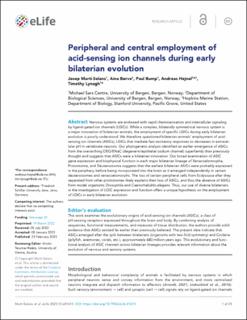| dc.contributor.author | Marti Solans, Josep | |
| dc.contributor.author | Børve, Aina | |
| dc.contributor.author | Bump, Paul | |
| dc.contributor.author | Hejnol, Andreas | |
| dc.contributor.author | Lynagh, Timothy Peter | |
| dc.date.accessioned | 2023-06-29T08:43:38Z | |
| dc.date.available | 2023-06-29T08:43:38Z | |
| dc.date.created | 2023-03-17T12:49:58Z | |
| dc.date.issued | 2023 | |
| dc.identifier.issn | 2050-084X | |
| dc.identifier.uri | https://hdl.handle.net/11250/3074296 | |
| dc.description.abstract | Nervous systems are endowed with rapid chemosensation and intercellular signaling by ligand-gated ion channels (LGICs). While a complex, bilaterally symmetrical nervous system is a major innovation of bilaterian animals, the employment of specific LGICs during early bilaterian evolution is poorly understood. We therefore questioned bilaterian animals’ employment of acid-sensing ion channels (ASICs), LGICs that mediate fast excitatory responses to decreases in extracellular pH in vertebrate neurons. Our phylogenetic analysis identified an earlier emergence of ASICs from the overarching DEG/ENaC (degenerin/epithelial sodium channel) superfamily than previously thought and suggests that ASICs were a bilaterian innovation. Our broad examination of ASIC gene expression and biophysical function in each major bilaterian lineage of Xenacoelomorpha, Protostomia, and Deuterostomia suggests that the earliest bilaterian ASICs were probably expressed in the periphery, before being incorporated into the brain as it emerged independently in certain deuterostomes and xenacoelomorphs. The loss of certain peripheral cells from Ecdysozoa after they separated from other protostomes likely explains their loss of ASICs, and thus the absence of ASICs from model organisms Drosophila and Caenorhabditis elegans. Thus, our use of diverse bilaterians in the investigation of LGIC expression and function offers a unique hypothesis on the employment of LGICs in early bilaterian evolution. | en_US |
| dc.language.iso | eng | en_US |
| dc.publisher | eLife Sciences Publications | en_US |
| dc.rights | Navngivelse 4.0 Internasjonal | * |
| dc.rights.uri | http://creativecommons.org/licenses/by/4.0/deed.no | * |
| dc.title | Peripheral and central employment of acid-sensing ion channels during early bilaterian evolution | en_US |
| dc.type | Journal article | en_US |
| dc.type | Peer reviewed | en_US |
| dc.description.version | publishedVersion | en_US |
| dc.rights.holder | Copyright 2023 the authors | en_US |
| dc.source.articlenumber | e81613 | en_US |
| cristin.ispublished | true | |
| cristin.fulltext | original | |
| cristin.qualitycode | 2 | |
| dc.identifier.doi | 10.7554/eLife.81613 | |
| dc.identifier.cristin | 2134765 | |
| dc.source.journal | eLIFE | en_US |
| dc.identifier.citation | eLIFE. 2023, 12, e81613. | en_US |
| dc.source.volume | 12 | en_US |

